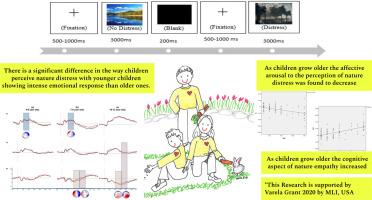Neural dynamics of development of nature empathy in children: An EEG/ERP study
IF 2.2
Current research in ecological and social psychology
Pub Date : 2024-01-01
DOI:10.1016/j.cresp.2024.100210
引用次数: 0
Abstract
This paper investigates spatiotemporal correlates of empathic concern for nature using the EEG/ERP method. The assessment of empathic concern for nature is of much utility as it could give us greater insights into conservation behaviors. Research studies investigating the development of empathy in young children inform us about the interplay of affective and cognitive aspects while perceiving other people in distress and its relationship with prosocial behaviors. However, it is not clear how the brain responds while perceiving nature in distress. Nor are the developmental dynamics of empathic concern for nature concretely known. In this study, eighty-three healthy children, 5–12 years (Mean age = 7.65 years and SD = 2.50 years, 35 girls) participated. Analysis of the differences in neural processing when perceiving images of nature in distress and no distress showed a significant main effect of stimulus type. There was a significant difference in the mean amplitudes of early and late ERP components for distress vs no distress, with distress eliciting a pronounced neural response. There were also significant interaction effects of laterality and age with stimulus type. Correlation analysis of differences in early and late components with age suggests shifting dynamics of empathy for nature from affective arousal to cognitive appraisal. In its novel attempt, this study provides neurophysiological support for the development of empathy for nature during childhood.

儿童自然移情发展的神经动态:脑电图/脑电图研究
本文利用脑电图/脑电波法研究了对自然的移情关注的时空相关性。对自然的移情关注的评估非常有用,因为它能让我们更深入地了解自然保护行为。对幼儿移情能力发展的调查研究让我们了解了在感知他人处于困境时情感和认知方面的相互作用及其与亲社会行为的关系。然而,我们还不清楚大脑在感知处于困境中的大自然时是如何做出反应的。人们也不清楚对自然的移情关注的发展动态。在这项研究中,有 83 名 5-12 岁的健康儿童(平均年龄 = 7.65 岁,标准差 = 2.50 岁,35 名女孩)参加了研究。通过分析儿童在感知自然图像时遇到困难和没有遇到困难时的神经处理差异,发现刺激类型具有显著的主效应。苦恼与无苦恼时,ERP 早期和晚期分量的平均振幅有明显差异,苦恼引起的神经反应更明显。侧位和年龄与刺激类型也有明显的交互效应。早期和晚期分量的差异与年龄的相关性分析表明,对大自然的移情动态已从情感唤醒转向认知评估。本研究通过新颖的尝试,为儿童期对自然的移情发展提供了神经生理学支持。
本文章由计算机程序翻译,如有差异,请以英文原文为准。
求助全文
约1分钟内获得全文
求助全文
来源期刊

Current research in ecological and social psychology
Social Psychology
CiteScore
1.70
自引率
0.00%
发文量
0
审稿时长
140 days
 求助内容:
求助内容: 应助结果提醒方式:
应助结果提醒方式:


